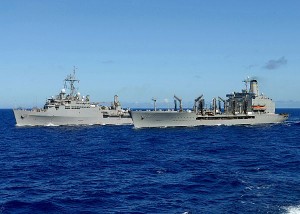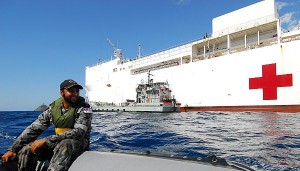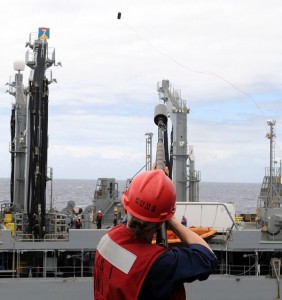 In the game of “annual” Navy conferences, it seems every naval “Community”, no matter how small, has a conference of their own. Sail on surface ships as a Line Officer? Go to the Surface Navy Association meeting. Special Operators have their convo. Submariners have theirs. Marines have a few. Aviators have whatever they are calling Tailhook now.
In the game of “annual” Navy conferences, it seems every naval “Community”, no matter how small, has a conference of their own. Sail on surface ships as a Line Officer? Go to the Surface Navy Association meeting. Special Operators have their convo. Submariners have theirs. Marines have a few. Aviators have whatever they are calling Tailhook now.
Everybody has a meeting.
Everybody, that is, but the Military Sealift Command. You know, that behind-the-scenes community of 10,000+? America’s third-largest Navy?
One of the few segments of the Navy that is actively growing?
They got nuthin’. And it is embarrassing. Look up “MSC annual meeting” in Google, and you get the Annual Mulch and Soil Council. And joining up with other communities won’t cut it–the MSC is just too broad, and in every other relevant community the MSC supports–like, say, the Surface Navy Association–the MSC is marginalized, and their presence barely acknowledged.
 And that’s frustrating–after all, who else sails most of the ships that are highlighted in CNO Greenert’s standard stump speeches? Which service community is receiving and shaking-down not one, but three new classes of ship–each with a rapidly-expanding set of missions (A missile range ship, the JHSV, the MLP and the AFSB)? The first that will be firing off a railgun? And, which naval organization will, within five years, be recapitalizing three to five different classes of ship–and a major portion of their tonnage?
And that’s frustrating–after all, who else sails most of the ships that are highlighted in CNO Greenert’s standard stump speeches? Which service community is receiving and shaking-down not one, but three new classes of ship–each with a rapidly-expanding set of missions (A missile range ship, the JHSV, the MLP and the AFSB)? The first that will be firing off a railgun? And, which naval organization will, within five years, be recapitalizing three to five different classes of ship–and a major portion of their tonnage?
The MSC.
These CIVMAR folks have a heck of a lot to talk about. Korea evacuation? MSC will find the hulls. Missile Defense in the Pacific? MSC folks own some of the radars. VLS re-supply? Sub maintenance? MSC. As a community, they have more than enough on their plate to successfully fill a two-day conference where MSC leadership–Rear Admiral Tom Shannon, Rear Admiral Larry Jackson, Command Master Chief Kevin Blade and Mr. John Thackrah–are the ring-masters. (Frankly, go read the comments on this post here, and…they suggest there’s a heck of a lot that needs talking about.)
Some “legacy” Navy communities may not appreciate this sentiment, but the MSC/civilian mariner crowd is a critical part of the Navy. And shuffling the MSC Command off to Norfolk won’t change things–major communities ignore them at their own peril.
If those communities don’t rely on MSC for logistics support today, the MSC is gonna nibble away at their mission niche tomorrow.
Civil Service Mariners (CIVMARs) are, arguably, the portion of the naval services undergoing the most change, and assuming the largest–and certainly the most momentous–shift in mission set than any other group, growing from “Beans, Bullets, Black Oil” logistics to, well, assuming the role as America’s low-end amphib, low-end aircraft carrier and low-end presence force, with platforms being used as everything from Special Operator platforms to ersatz Coast Guard cutters–to, heck, with the AFSB, a slow-moving baby carrier.
If there’s a group that needs an annual meeting, it’s these MSC/CIVMAR sailors.
Here’s a Proposed Agenda:
Opening: The MSC Today–Rear Admiral Tom Shannon
Keynote: CNO Admiral Greenert’s MSC and Payloads
The MSC’s Future in Support of Fleet: N4, with maybe N95, N96 as a panel.
Keynote II: Deputy SECDEF Robert Work: Introducing The National Fleet
New Platform Report: Skippers discuss JHSV, MLP and the Howard O. Lorenzen.
Future Platform Report: NAVSEA Program Managers and their MSC counterparts discuss AFSB, T-AO(X), T-ATF(X), T-ARS(X) and the CRAGSIDE.
Splinter Discussions:
Manning: Command Master Chief Kevin Blade–open discussion of manning challenges.
Industry Perspective: A Panel of Maintainers and Ship Operators mix it up with MSC.
Foreign Perspective: A Panel from countries who have similar MSC/CIVMAR-like organizations, new procurements–UK, Canada…Japan?
MARAD Ready Reserve Force: Panel on keeping the logistics force relevant and more easily integrated with the fleet.
Historical Perspective: Discussion of past logistics heroes, like, say: USS Neosho (AO-23)
DAY 2:
Opening: New Horizons For MSC--Rear Admiral Larry Jackson
Keynote I: SECNAV Ray Mabus: Platforms Matter
MSC at the Poles: Panel discussion the Coast Guard, National Science Foundation, Navy, maybe some think-tank heavies.
MSC in the Pacific: Somebody from Korea to discuss Korean scenarios, somebody from the fleet to discuss logistical needs, somebody to discuss forward basing.
MSC at the Pointy End: What happens when MSC is engaged, Forward? Panel discussion to discuss, say, South China Sea flashpoints–perhaps led by skippers of the USNS Impeccable (T-AGOS 23) and USNS Victorious (T-AGOS 19).
MSC at Home: Panel discussion with Coast Guard, Customs and FEMA to discuss MSC contributions to USCG patrol mission, Homeland Defense, and Disaster Recovery.
Congressional Lunch: I’d pick Seapower Congressman Forbes since he’s the one of the more strategically-inclined members of Congress.
Split Command and Hybrid Crews: A panel on how to negotiate Title X issues.
MSC Free Discussion: Standard Commentary Panel: Dean of Navy Press Corps, Chris Cavas; Ron O’Rourke, Eric Labs.
An annual event like this would do a lot to raise morale in the MSC Fleet, help build better links with the wider Navy, and raise the profile of the larger “National Fleet.” It would go a long way in resolving issues that are bubbling up within the wider CIVMAR community….And yes, it’ll cost, but…MSC folks…It needs to happen.
Heck, I’ll organize it if somebody will help fund it! Thoughts?


{ 4 comments… read them below or add one }
Boatswain I have to disagree. First off, I worked at MSC HQ and I am not sure where you are getting the idea of a Kings Point mafia – I actually wish more people at HQ and the area commands had a better understanding of the merchant marine (plus I went to SUNY Maritime).
The reason that CIVMARS, as you said, “lack the tact and skill” is that they are not integrated into the command at various levels. One of the biggest complaints against MSC is the crewing of CIVMARS is excessively long at sea tours. When I sailed 6 months was the assignment, but it typically ran from 8 to 9 months. Today, it is touted as 4 months, but with training and requirements, it still requires at least 6 months to get up to required levels. Then mariners are constrained by federal civilian leave criteria and they have to report back at a certain date or be considered AWOL. Unlike Navy tours, which rotate between at-sea and shore billets, all MSC positions are afloat.
If, for example, 2nd Mate/2nd Engineers are given assignments to MSC similar to junior officers, along with Chief Mates/1st Engineers, then this tact deficit that you are referring to can be rectified.
MSC mariners are not just contractors who are working ashore, but fully integrated civil servants in the battle force and providing key logistics for both the Navy and the Department of Defense. The fact that they are not represented in the command structure of not just MSC, but also TRANSCOM and DOD is a major issue.
When MSTS was created, the Army had been the main user of merchant shipping and they relied on their merchant masters/chief engineers to provide the needed guidance and advice to their senior leadership. When Admiral William Callaghan stood up the service, he had an industry adviser as his special assistant and created a reserve policy board made up of leaders from the main shipping companies, shipyards, and unions that he could meet with to provide viewpoints on the industry.
Why is it that the Royal Fleet Auxiliary can operate as a civilian agency since 1911 and why was it that the War Shipping Administration, led by Emory S. Land (a retired Navy Vice Admiral), could orchestrate the largest sealift operation in history but retain its civilian structure under a new organization – the United States Maritime Service (USMS).
There was a day when the merchant marine and the navy formed the two halves of Sea Power, as defined by Mahan. Today, within the military, the Military Sealift Command – the largest operational fleet in the Navy, and the largest user of merchant ships in the United States – does not get the respect it deserves and your final comment reflects that by saying that all they need to do is “tell them where to go and who to RAS”. I am sure that any branch of the Navy, surface warfare, submarines, aviators, or SEALS would have a major problem with having their operations directed by those who are not fully versed in the capabilities, abilities, and limitations of their branches.
Yes, civilian merchant mariners are civilians, but in time of war, they die like veterans – just without the recognition or benefits.
|Why is it that the Vice Commander of MSC is not a merchant master or chief engineer, let alone an area commander?
Because MSC is still a military organization much to the chagrin of the Kings Point mafia at MSC HQ. The CIVMAR Masters lack the tact and skill to converse properly with the various local, Fleet, and Joint Commanders that the average Navy O6 and above have developed over the years.
CIVMARS of all stripes are great at doing their jobs. But doing their jobs is just going where the various CTF X3 and MSC Area Commanders tell them where to go and who to RAS.
Great comment Sal. These are precisely the things that can be brought up and addressed in something like an annual convo. I hate the idea of ginning up “another” annual meeting, but if there’s a community that has some weighty things to discuss, it’s this vital yet under-appreciated group.
As a previous mariner and currently writing a history of the Military Sealift Command, one of the biggest issues missing from your proposed agenda is the voice of the merchant mariners.
Unlike the Royal Navy’s RFA, which is commanded by those who sailed the ships, MSC is a naval organization that fails to adequately utilize its crews with vast experiences in its command structure. Why is it that the Vice Commander of MSC is not a merchant master or chief engineer, let alone an area commander?
One of the major issues voiced by those who sail as civilian mariners is the increasing militarization of the command and the detachment of the administrative functions and areas with the real world operation of the vessels. As originally organized in 1949 under Vice Admiral William Callaghan, MSTS pulled upon the experience of their crews and naval officers with experience in the world of naval logistics.
I completely agree with your concept of a MSC command, but issues of crew retentions, rotations, expanded training requirements, and civil/military status all need to addressed.